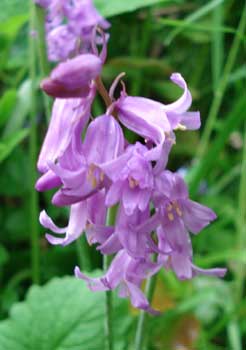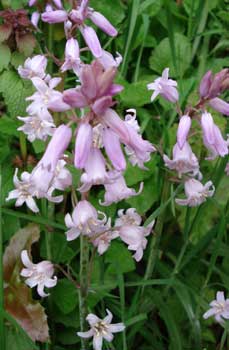
Pink Squill
or, 'Rosabella' Spanish Bluebells
"Daylong she had been coming,
And all the forest sang
Of beauty: elfin-softly
The bluebells rang."
-William Griffith
(1876-1936)
Pink Squill, or Pink Spanish Bluebells (Hyacinthoides hispanica forma rosea) had its first cultivar name as 'Rosabella.' This mid-pink bluebell tends to be fairly large & has no scent. Though it's a hybrid of both Spanish & English strains, its large size & lack of scent identifies it most closely with Spanish Bluebell.(1876-1936)
 'Rosebella' is a very old strain dating to 1601 in the literature. By & large it shouldn't be distinguished from any pink squill sold as 'Rosea' or simply as 'Pink' though some would reserve 'Rosabella' for those which are the most evenly pure pink, neither washed out to pinkish white, nor with the darker stripe & intenser violet-pink of 'Queen of Pinks.'
'Rosebella' is a very old strain dating to 1601 in the literature. By & large it shouldn't be distinguished from any pink squill sold as 'Rosea' or simply as 'Pink' though some would reserve 'Rosabella' for those which are the most evenly pure pink, neither washed out to pinkish white, nor with the darker stripe & intenser violet-pink of 'Queen of Pinks.'The select strain of the old 'Rosebella' sold as 'Queen of Pinks' also has large & vigorous foliage, with flower stems that can almost reach two feet in an old clump. The blooms are larger than on many regular blue Spanish bluebells, matching the larger-belled blue strain 'Excellsior.'
Our pink squills did not come any named cultivar source. They were spotted along a shady roadside area of wildly naturalized blue squill, with just a few patches of pink here & there. I dug out a few of the pink, evading the blue. I didn't take them all as I didn't want to deprive other passersby of seeing them, but alas two years later the road was widened & out came a lot of the trees that shaded the drive, & all of the roadside squill ended up under pavement. But at least I happened to save a few of them.
In our garden these are intensely aflower throughout April, & are a very rich pink in the shade, a mite more faded in the sun. They will still be around in early May, with the tip-buds having opened last & still fresh. The grass is sixteen to twenty inches tall, very large & vigorous from the largest oldeset bulbs. The flower stems reach a full two feet.
We've two patches of the pink, one in deep dry shade, the other in a sunny spot under the mailbox. Those under the mailbox bloom later & have not been as impressive, but those in dry shade are just spectacular. Not long ago I added a third patch, saving some "stunted" pink squills from another roadside location where parked cars had made the ground hard & still the poor feeble squills managed to bloom. In their new location with good soil, again in dryish shade, they've flourished wonderfully.
Blue squills have naturalized throughout our neighborhood & I always notice when there are one or two pink patches. They're surprisingly rare. The thing is, from their own seed they produce very few pink flowers, but mostly blue. When a pink one does crop up, it will over time offset some bulblets, reproducing itself clonally.